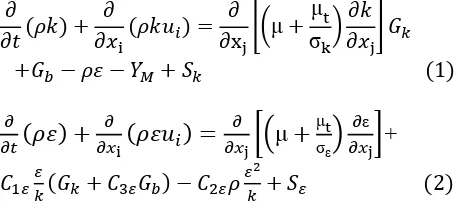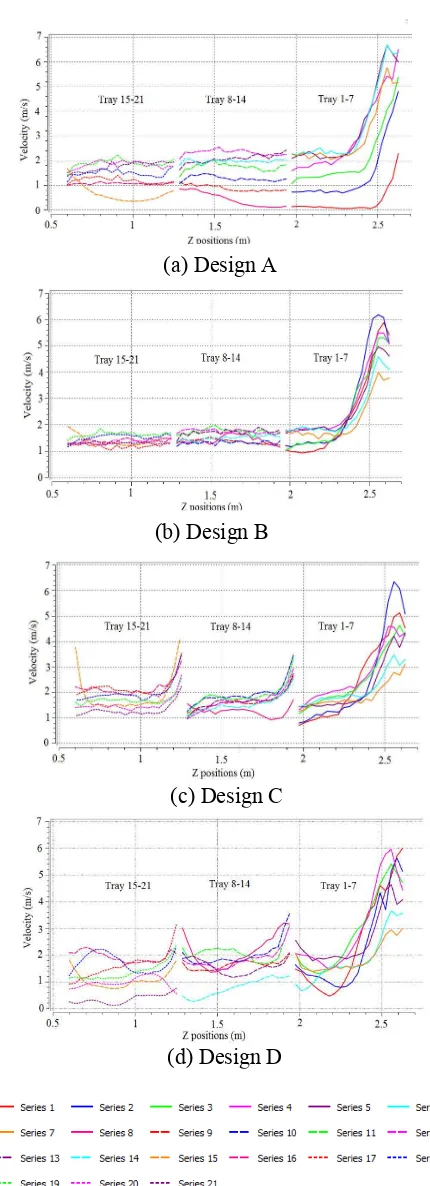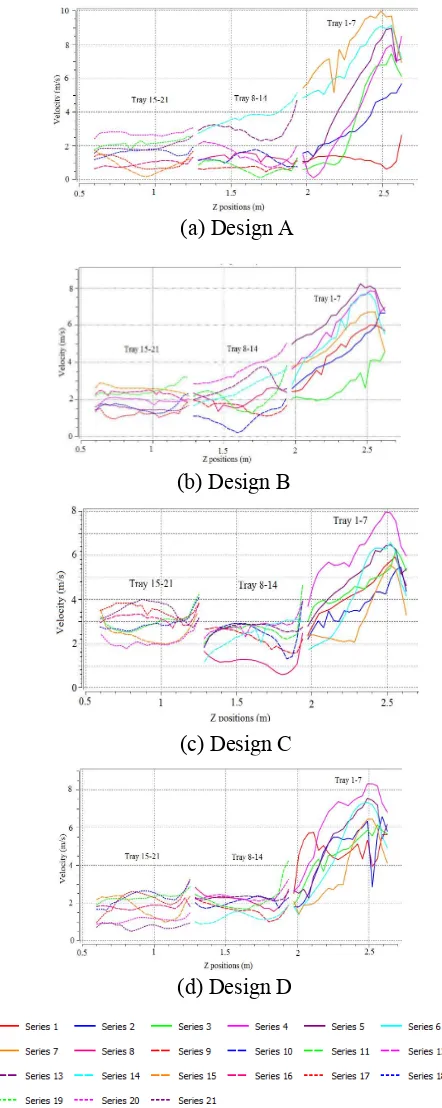SUHAIMI MISHA
1,2,a*, SOHIF MAT
1,b, MOHD HAFIDZ RUSLAN
1,c,
KAMARUZZAMAN SOPIAN
1,d, ELIAS SALLEH
1,e1
Solar Energy Research Institute, Universiti Kebangsaan Malaysia,
43600 Bangi, Selangor, Malaysia
2
Faculty of Mechanical Engineering, Universiti Teknikal Malaysia Melaka,
Hang Tuah Jaya, 76100 Durian Tunggal, Melaka, Malaysia
a
[email protected],
b[email protected],
c[email protected],
d[email protected],
e[email protected]
Abstract: Tray dryer is the most widely used because of its simple and economic design. The product is spread out on trays at an acceptable thickness. In a tray dryer, more products can be loaded as the trays are arranged at different levels. Most tray dryers use hot air stream where water is vaporized from the product and removed by air stream. The drawback of this dryer is non7uniformity in the desired moisture content of end product. The key to the successful operation of the tray dryer is uniform airflow distribution over the trays. Therefore, the good design of the drying chamber configuration in a tray dryer is necessary to obtain optimum performance. This research is to design the uniform airflow distribution throughout the drying chamber using CFD simulation. The products are represented by porous and solid (non7porous) product. Several configurations of trays position also was designed and simulated to determine the tray dryer with better airflow distribution. It was found that by using porous product the overall velocities in the drying chamber are lower than solid product since some of the hot air stream pass through the porous product. The design C was recommended to be developed for both porous and solid product which can produce more uniform drying and shorter drying time because of good temperature and velocity distribution throughout the drying chamber.
Key Words: Drying simulation; Tray dryer; Uniform drying
The measurement of drying parameters in the drying chamber is expensive, difficult, and time consuming, as sensors and data loggers have to be installed in many positions, especially in a large7 scale dryer. Computational fluid dynamics (CFD) simulation is used extensively because of its capability to solve equations for the conservation of mass, momentum, and energy using numerical methods to predict the temperature, velocity, and pressure profiles in the drying chamber.
An industrial batch7type tray dryer for drying fruits has been designed and constructed by Mathioulakis et al. [1]. CFD is used to simulate the air pressure and the air velocity profiles in the drying chamber. The result shows that comparison of the simulation result by the CFD and experimental data shows a strong correlation between drying rate and air velocity. Dionissios and Adrian7Gabriel Ghious [2] studied the numerical simulation inside a drying chamber. A set of measurements was obtained experimentally above
one single tray to validate the model. The validation between the measured data and the simulation results by CFD shows that the standard k–e model is the most adequate turbulence model.
Mirade [3] using a two7dimensional CFD model with time7dependent boundary conditions to investigate the homogeneity of the distribution of the air velocity in an industrial meat dryer for several low and high levels of the ventilation cycle. All airflow simulations are consistent with the heterogeneity of drying usually observed in practice. The product is represented by solid rectangle object.
C, D prescribed matrices σk turbulent Prandtl numbers for k C0, C1 empirical coefficients σε turbulent Prandtl numbers for ε
Cij prescribed matrices E total energy
Dij mass diffusion coefficient vi velocity vector
ρ density of fluid vmag velocity magnitude
k turbulent kinetic energy (τij)eff deviatoric stress tensor
ε rate of dissipation p pressure
I dynamic viscosity Prt Prandtl number
It turbulent viscosity T temperature
Gk generation of turbulent kinetic energy cp specific heat capacity at constant
due to the mean velocity gradients pressure
Gb generation of turbulent kinetic energy u velocity magnitude in x direction
due to buoyancy t time
YM contribution of the fluctuating dilatation Sk, Sε, Sh user7defined source terms
in compressible turbulence to the overall Si source term for ith momentum
dissipation rate equation
C1, C2, C3 constants used in turbulent model
a drying oven using the CFD simulation. Several new configurations were simulated to improve uniformity of temperature in the drying chamber. A new shape and position of the heater and additional baffle directing the airflow were found as the most effective. The simulation results show very good agreement with the experimental data.
The use of CFD as a tool to manage the velocity, temperature, and pressure in the drying chamber can be carried out to design a new dryer system. The objective of this research is to design the large scale tray dryer for any product. The dried product can be represented as a solid or porous media depending on the character of the product. The CFD is used as a tool to predict the airflow distribution in the drying chamber to obtain the uniform drying. CFD has also been widely used in food industry to investigate the flow pattern of the air in the drying chamber [6,7]. Uniform airflow distribution in drying chamber is very important because it gave significant effect on the efficiency and the homogeneity of the products being dried. The use of desiccant material in drying application would also improve the uniformity of dried product, among other advantages [8].
The dryer system obtained heat from the solar energy. The water7to7air heat exchanger is used to heat the air at inlet 1 and 2. The water is circulated through the solar collector and heat exchanger. The fan is used to force the air stream pass through the
heat exchanger in the cross flow direction. However the experimental setup is not shown in this paper since the focus of this paper on the drying chamber configuration.
!
!
"
The wall of dryer system will be constructed by hollow poly carbonate with 6 cm thickness, 4 cm hollow in the middle. The layout of the drying camber is shown in Fig.1. The drying chamber dimension is approximately 2 m x 3 m x 1.7 m width, length and height, respectively. The dryer system consists of 7 levels of tray system and each level has 3 separated trays. Several configurations of
drying chamber and trays position was designed and simulated to find the most optimize design. After investigates many designs of drying chamber and trays position, four designs were selected as shown in Fig.2. The thickness of the products in each tray is 6 cm. The velocity and temperature distribution were analysed to ensure the uniform drying throughout the drying chamber.
# $
! %&
The mass, momentum and energy conservation result in the continuity, Navier7Stokes and energy equation, respectively [9]. The turbulent model is used in this CFD simulation. The turbulent kinetic energy, k, and its rate of dissipation, ε, are calculated from the following transport equations [10]: k 7ε models is given by the following equation:
∂ parts: a viscous loss term and an inertial loss term.
S >? @ IA ? c 1 Fluent 12.1 has been used for solving the equations. All the geometrical configurations were displayed in Fig.2. They were used to build up a numerical model based on an unstructured three dimensional mesh by tetrahedral cell. The pattern of air stream in the drying chamber is important and since there was
no variable condition in this study, the simulation was carried out in steady state condition. The plane 1 was selected (Fig.1) to study and analyse the conditions were defined as followings:
Inlet 1: air mass flow rate 1.715 kg/s (approximately velocity of 8.8 m/s normal to air inlet) and air temperature of 75oC. Inlet 2: air mass flow rate 0.8575 kg/s (half of the inlet 1 but give same velocity, 8.8 m/s) and air temperature of 75oC.
Outlet: Assuming gauge pressure=0 at the outlet.
Product: The trays were assumed as porous product with 10% porosity (case 1) and symmetry surface to the middle boundary.
' (
The most suitable design can be assessed by comparing the uniformity of air flow distribution in the drying chamber. Even though the simulation was done in three dimensions but the analysis was carried out only at plane 1 as indicated in Fig.2. Several planes have been studied but plane 1 is among the poor zone in term of hot air distribution since it was located in between the two fans. Therefore the study is focus on plane 1 and assuming others plane have better hot air distribution. The simulation was carried out and the temperature distribution profile at plane 1 for porous product is shown in Fig.2.
72.90C. The difference of temperature among the trays for both cases is considered small and it can be assumed that all design successfully achieved the reasonable uniform air temperature in the drying chamber. The porous and solid product not gave significance effect on the temperature distribution in the drying chamber. The numbers of trays from 1 to 21 were indicated in Fig.2(a).
Fig.2 Design of four drying chamber and temperature distribution profiles using CFD simulations at plane 1 for porous product
In drying application, the temperature, velocity and humidity of drying air condition gave significant effect to the drying process. In this simulation study, only temperature and velocity of the drying air can be analysed since the equation used is not involved humidity. Humidity analysis will be done in the
future experimental work. The air velocity above the trays are very important to carries the moisture from the product. The air velocity along the trays was studied in this simulation. The air velocity profile at
Fig.3 Result of air velocity against tray positions (along Z axis) for porous product
(a) Design A
(d) Design D (c) Design C (b) Design B
(d) Design D (c) Design C
(a) Design A
2.5 cm above the trays for each tray is shown in Fig.3 and Fig.4 for porous and solid product, respectively. Generally the average air velocities at trays 1 to 7 are higher than other trays since the positions are close to the air inlet. Based on design A and B, as the drying air passes over the trays, the air velocity would decrease. Based on Fig. 3(a) the air velocities at the first and second level of trays (from top) are lower than 1 m/s which are not good for the drying process. The air velocity was improved by adding baffle to channel the airflow to the first and second level of trays as shown in Fig 3(b). The air velocities achieved at least 1 m/s for all trays and look more uniform in the range of 1 to 2 m/s except for the first column of trays with the maximum velocity of 6.2 m/s.
Since the baffle was improves the air velocity profile, the baffle is maintains in the next design and different trays position were studied. In design C, all the trays are exposed directly to the airflow. It shows that the air velocities are higher at the front of each tray and lower at the rear of the tray except for tray number 15 because the airflow through the small area (Fig.3(c)). In this design additional baffle is required to improve the airflow at the first level of tray. In general the air velocities profiles at trays 8 to 14 and trays 15 to 21 are higher than design B. However the air velocity at ends of trays 1 and 2 are lower than 1 m/s (minimum 0.7 m/s). In design D, the trays 1 to 7 and trays 15 to 21 are placed at the same level as in design A and B but the trays 8 to 14 are place in between the existing levels. The design was increased air velocities at certain area but there are several trays with low air velocity, below than 1 m/s (Fig.3(d)).
Based on Fig. 4(a) the air velocity at the first top three of trays level are lower than 1 m/s. The velocity was improved by adding baffle as shown in Fig. 4(b). The velocities exceed 1 m/s for all trays except tray number 10 with minimum air velocity at 0.3 m/s. In design C, the velocity profiles are more uniform and the air velocity at trays 8 to14 and trays 15 to 21 were increases as shown in Fig. 4(c). The average air velocity is approximately 3 m/s and only little part of tray number 8 not achieved 1 m/s (around 0.6 m/s). In design D, the air velocity for all trays also achieved 1 m/s except for tray number 21 with minimum air velocity at 0.6 m/s (Fig 4(d)). However, in general the air velocity at trays 8 to 21 is below 2.5 m/s which are lower than design B and C.
The temperature profiles for all design (design A,B,C and D) and cases (porous and solid product) are considered successfully achieved the reasonable uniform air temperature distribution in the drying
chamber. However the air velocities above the trays are different for each design and case.
Fig.4 Result of air velocity against tray positions (along Z axis) for solid product
Basically the velocities at the above of trays in the drying chamber are higher for solid product compared to the porous product. This is because some of the hot air pass through the product at very
(c) Design C
low velocity and reduce the velocity value around velocities compared to others proposed design. Design C also can be considered since the average air velocity is higher than design B and only a little area of trays with air velocity below 1 m/s. While for solid product, the design C shows more uniform air velocities and gave the highest average value of air velocities compared to others proposed design.
Different values of porosity applied to the product will influence the temperature and velocity profile in the drying chamber. The parameters required to change the porosity of the product in CFD simulation are viscous resistance and inertial resistance as stated in equation 4. Some product can be assumed as solid (non7porous) material especially for very fine product where there is less space to be occupied by the air. However most of the product can be represented by porous media.
Mesh adaption need to be performed in the simulation work to ensure the solution is mesh independent and to obtain more accurate result. Several locations in the drying chamber have to be measured by experiment to validate the data.
)
Good air flow distribution throughout the drying chamber can improve the drying uniformity. CFD designs. The results shows that additional baffle directing the air flow give better result in term of for porous and solid product, respectively. Therefore for more versatile dryer, design C was recommended to be developed to dry porous and non7porous product with good drying uniformity and higher efficiency. The actual dryer will be dryer by computational fluid dynamics: Application for the drying of fruits, Journal of Food Engineering, Vol.36, 1998, pp. 1837200. [2] P. Dionissios, Margaris, Adrian7Gabriel
Ghiaus, Dried product quality improvement by air flow manipulation in tray dryers, Journal of Food Engineering, Vol.75, 2006, pp. 5427550. [3] P.S Mirade, Prediction of the air velocity field
in modern meat dryers using unsteady computational fluid dynamics (CFD) models,
Journal of Food Engineering, Vol.60, 2003, pp. 41–48.
[4] Chr. Lamnatou, E. Papanicolaou, V. Belessiotis, N. Kyriakis, Finite7volume modelling of heat and mass transfer during convective drying of porous bodies 7 Non7 conjugate and conjugate formulations involving the aerodynamic effects. Renewable Energy, Vol.35, 2010, pp. 139171402.
[5] Jacek Smolka, Andrzej J. Nowak, Dawid Rybarz, Improved 37D temperature uniformity in a laboratory drying oven based on experimentally validated CFD computations,
Journal of Food Engineering, Vol.97, 2010, pp. 3737383.
[6] P. Verboven. N. Scheerlinck, J. De Baerdemaeker, B. M. Nicolaï, Computational fluid dynamics modeling and validation of the temperature distribution in a forced convection oven, Journal of Food Engineering, Vol.43, 2000, pp. 61–73.
[7] G. Scott, P. Richardson, The application of computational fluid dynamics in the food industry, Trends in Food Science and Techology, Vol.8, 1997, pp. 119–124.
[8] S. Misha, S. Mat, M.H. Ruslan, K. Sopian, Review of solid/liquid desiccant in the drying applications and its regeneration methods,
Renewable and Sustainable Energy Reviews, Vol.16, 2012, pp. 4686–4707.
[9] T. Norton, D.W Sun, Computational fluid dynamics (CFD) – an effective and efficient design and analysis tool for the food industry: a review, Trends in Food Science and Techology, Vol.17, 2006, pp. 600–620.
[10] O. Yongson, I.A Badruddin, Z.A. Zainal, P.A.A Narayana, Airflow analysis in an air conditioning room, Building Environment,
Vol.42, 2007, pp. 1531–1537.



